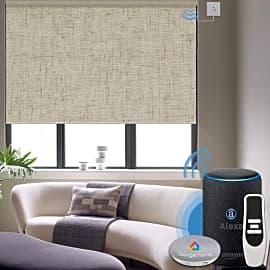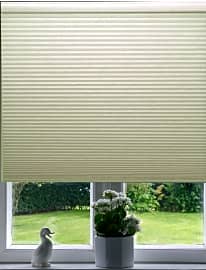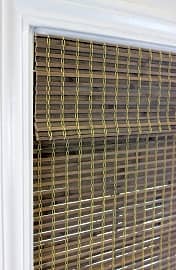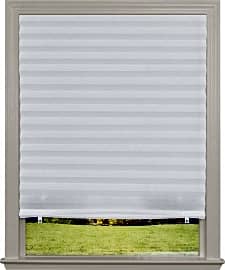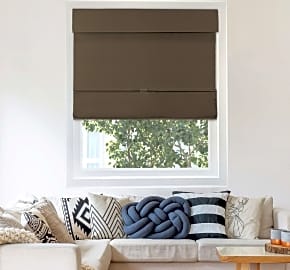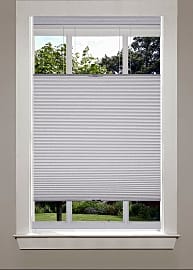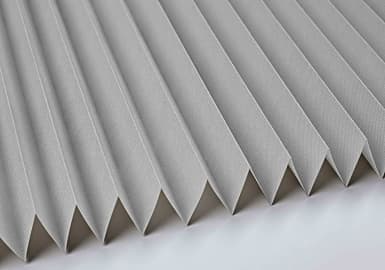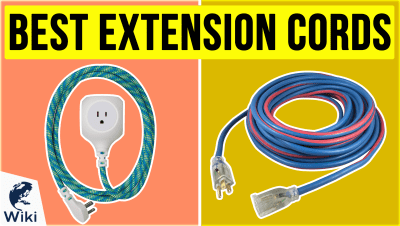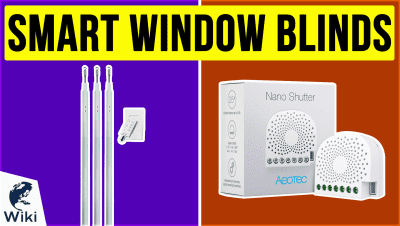The 10 Best Cordless Window Shades

This wiki has been updated 32 times since it was first published in February of 2017. Cordless window shades have a modern, clean look that most homeowners prefer, and they are also safer to use in homes with young children than standard blinds with potentially dangerous, dangling strings. These convenient options are often energy efficient and add warmth and ambiance to your decor, too. We’ve ranked the selections on this list by durability, design, and price. When users buy our independently chosen editorial choices, we may earn commissions to help fund the Wiki.
Editor's Notes
March 03, 2021:
Most of our existing choices were still great picks for the category, so there wasn’t a terrible amount of heavy lifting that needed to get done during this round of updates. However, we did let the Chicology Zebra and Miro Trimmable go, noticing that neither option was available at the time of this update.
We replaced our two fallen selections with a pair of motorized models that we thought were likely to appeal to heavy-walleted users shopping in this category, as they combine the cordless styling that’s seen in this space with convenient control options. The Graywind Roller Shade and Yoolax Motorized can both be operated via infrared remote control or several popular smart-home systems, but you might need to purchase some separate hardware to make it happen — the Yoolax model needs a hub for voice control and the remote for the Graywind is sold separately.
Both our new choices also present small problems when it comes to powering them. The Yoolax is battery powered – and it can run three to six months on a charge, which is nothing to sneeze at – but if you want to keep it running continuously and indefinitely, you’ll likely need to purchase a small solar panel separately, which doesn’t necessarily mean that you’re in for a massive expense, but is still likely to amount to a small inconvenience and potential eyesore. By contrast, the Graywind is a plug-and-play model, but its power cord is only two meters long, so it’s unlikely that it’ll reach the nearest outlet. With that in mind, you may either be looking at another eyesore – in the form of an extension cord – or a frustrating afternoon fumbling with a wire fishing tool to get a new plug installed. (If you’re not qualified for this, we strongly recommend calling in a reputable, licensed electrician, for safety’s sake.)
Rereading this editor’s note, it occurs to me that, based on all this, our new options sound rather horrendous. So, to be clear: They’re not. We included them on our list because we thought they were great options, and we’ve discussed their shortcomings here to help you make the best purchase decision possible, but certainly not to scare you away. The Graywind and Yoolax can control nine and 15 blinds simultaneously, respectively, and are likely to make a great addition to many modern homes. If they look enticing to you, perhaps you’ll be interested in taking a look through our list of smart window blinds.
July 06, 2019:
Many homeowners opt for the neat, clean look of cordless shades. They’re kid- and pet-friendly, thanks to their lack of a pull cord or chain. They range from completely opaque selections to those that let in some light for a sedate atmosphere. Our list provides choices in a range of colors and thicknesses, equipped with a variety of different mechanisms for adjustment.
In this update, the Arlo Blinds Blackout makes its way into the top three choices, thanks to its unique, silver foil lining that can provide you with both a darkened room and sound absorption. It provides a level of insulation that can help to reduce or heating and cooling costs. It’ll fit almost any window, thanks to its wide range of available sizes, and the ivory or white options are neutral enough for any décor. It slides up and down easily by way of the bottom PVC rail, which matches the one at the top.
The Window and Garden retains its top spot as a versatile choice that can be opened top-down or bottom-up, and chances are you’ll find just the right size you need. If not, the manufacturer can cut yours down to within an eighth of an inch. Color options include Antique Linen, Bay Leaf, Amber, Cool Silver, Daylight, Espresso, and more.
Another reliable and stylish option is the Bali Blinds Cellular, which can lower the level of light without completely blocking it. Its durable fabric resists tearing and wrinkling, so it’ll stay looking crisp and fresh over time. Its cordless lift raises or lowers it smoothly with just a simple touch.
Special Honors
Select Blinds Classic Cordless Blackout Shade This attractive, polyester selection is great for blocking light, and it comes in six neutral colors. It conveniently comes in a wide range of sizes, so you’re likely to find a suitable one even for a non-standard size window. It’s energy-efficient, 3/4-inch single-cell pleats are easy to clean with a feather duster or vacuum. It’s covered by a generous, three-year warranty. selectblinds.com
Blinds.com As the name might've helped you guess, this website specializes in everything blind-related, including a wide selection of cordless window shades, but also extending well beyond that into everything from vertical blinds to skylight shades. blinds.com
A Brief History Of Shade
In spite of its multitudinous meanings and connotations in contemporary English, the term shade derives from a relatively simple concept.
In spite of its multitudinous meanings and connotations in contemporary English, the term shade derives from a relatively simple concept. In its most basic form, it’s anything that stands (or hangs) between us and a light source. Seeking shelter from nature’s harsher elements is an impulse common to nearly all animals. From birds that huddle together for warmth in the protection of their nests, to primates that convert whatever they can find into rain canopies, most species will make an effort to avoid getting drenched or scorched if at all possible. This instinctive avoidance has become something of an obsession among humans, who will not only duck for cover in inclement weather, but also go to extremes in search of something like a Goldilocks zone of environmental conditions.
While early mankind may have cozied up to an open fire when temperatures dropped, and hunkered down in caves or forests to escape the sun’s blistering rays, the desire to be more than just safe from harm — to be comfortable — drives an almost insatiable need in humans to adapt our environments to suit ourselves, rather than the other way around. Even within the cushy confines of our climate-controlled homes, we hominids invest heavily in all manner of window treatments to maintain the ideal ambient temperature and have control over when and how light crosses the threshold of our domiciles.
Back when exterior-mounted shutters were the only window coverings available, they were primarily used to protect a home’s interior against high winds, hail, and extreme heat. With the advent of draperies, so-called Venetian blinds, and other interior shades, we can now control window coverings from within at the touch of a button or the pull of a cord.
What's On Your Windows?
In the United States, the most popular types of window treatments are draperies and blinds, with slats or vertical blinds largely dominating the rental market. Although landlords and property managers aren’t required by law to provide window coverings, they often choose to because the alternative of leaving it up to tenants to provide their own can be a nuisance. Renters may choose to put up all sorts of makeshift window coverings, from mismatched sheets and blankets to taped-together sections of cardboard, to avoid the expense and hassle of hanging curtains or measuring for blinds. Ultimately, though, property owners are the ones who’ll get in trouble with the homeowners’ association or local authorities over unauthorized or unsightly modifications to their properties.
Private homeowners and long-term renters have a wider array of options, but the cost and hassle of installing and maintaining custom window treatments can be prohibitive.
Modest rentals and apartment complexes often feature bargain-priced, off-the-shelf aluminum or vinyl blinds, which are fairly interchangeable, easy to install, and easily replaced. More upscale rental accommodations may come with wooden slats or higher-end shades. Private homeowners and long-term renters have a wider array of options, but the cost and hassle of installing and maintaining custom window treatments can be prohibitive. In homes where window-mounted fans or air conditioners are used, blinds and shades are also easily raised or lowered to make room for the cooling unit without getting damaged or turning occupants into exhibitionists.
Depending on the region and inhabitants’ lifestyles, blinds, shades, and blackout curtains may serve the additional purpose of turning day into night for those who work the graveyard shift, or who just aren’t ready to have the sun kiss their noses at what’s supposed to be zero-dark-thirty. The need for heavy-duty, light-blocking window treatments is readily apparent for folks who work nights and sleep in the daytime. On the other hand, lifelong residents of our lower latitudes may not realize how much earlier dawn comes in the warmer months the closer you get to the Arctic Circle. Heavier window coverings in the northernmost states and Canada may be key to getting a decent night’s rest for at least part of the year. And as frequent travelers can attest, a darkened room can help reset an internal clock that's gone haywire as a result of rapid changes in location and time zone. Even the humblest hotel's blackout curtains can be pure bliss for a jet-lagged brain.
Cutting The Cord
Circadian rhythms aside, there are other, more pressing concerns for parents and pet-owners when it comes to window coverings. Draperies and curtain rods pose a certain risk of injury if they’re improperly installed or pulled on too hard. Whether it’s a feline game of chase involving a weighty set of curtains, or children thrilling to the satisfying snap of a shade’s automatic retraction system one too many times, it’s all fun and games until someone gets conked on the noggin by falling draperies or shade cartridges.
Among those cases, more than 12 percent involved cord entanglement.
Even more hazardous, as it turns out, are the cords that enable shades and blinds to be opened, closed, and adjusted for more or less light filtration. To imagine entering a room where a small child or beloved pet has become entangled in those cords while left unattended is the stuff of nightmares, but as a recent study shows, more than 16,000 American children were admitted to the ER for injuries associated with window blinds in the years between 1990 and 2015. Among those cases, more than 12 percent involved cord entanglement. And of those whose injuries were caused by entanglement, two-thirds died, at a rate of nearly one child per month over a 25-year period.
Tragically, in spite of safety campaigns and frequent warnings from the Consumer Product Safety Commission, among others, injuries and deaths associated with corded blinds remain an all-too-common occurrence. Although new legislation aims to have virtually all cord-operated blinds removed from the market, it will be a long time before corded blinds have been removed from most or all of the homes where children and pets live and play. So, if you’re shopping for new window treatments, especially if you have corded window blinds, consider replacing them with cordless Roman shades or another option that features a safer, enclosed mechanism for raising, lowering, and adjusting them.


